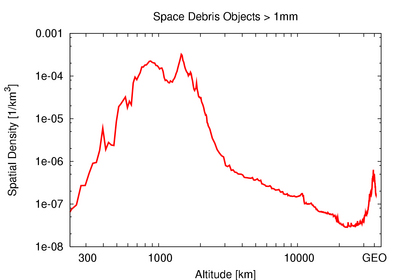OpenSpace 3
SPACE ELEVATOR VERSUS SPACE DEBRIS
The new method for eliminating the space debris at Low Earth Orbit (LEO) and Geostationary Orbit (GEO) is presented here. The paper shows how the Space Elevator can be used in struggling against the space debris that would be possible by means of deploying the huge metallic petals onboard the Space Elevator’s cabin moving along the cable.
Introduction
The space debris is the objects in orbit around Earth created by humans that no longer serve any useful purpose. They consist of everything from entire spent rocket stages and defunct satellites to explosion fragments, paint flakes, dust and slag from solid rocket motors, and other small particles that are much more dangerous since it is more difficult to oversee them than large objects.
Since the beginning of the Space Age in 1957 a great amount of satellites have been sent into space and this increasing number is/will be (especially in future) a great problem. According to some assessments the space debris belt will very soon make problems even for putting the satellites on the orbit around the Earth. As known, more and more countries are getting involved in space exploration and therefore number of objects (both active and “dead” satellites) in space will increase rapidly. The worst thing is that the satellites are colliding to each other and thus creating more and more little objects (their fragments) around the Earth that are much more difficult to deal with than with big objects.This effect is known as “Kessler Syndrome” [1] [2]. One of such collide occurred in 2009, 10 of February when the inactive satellite Kosmos-2251 collided with active one Iridium 33 above the northern Siberia with the speed of 42 120 km/h. This collision destroyed both satellites and gave birth to one more space debris cloud consisting of numerous little objects (there are at least one thousand objects in this cloud with the size of more than 10 cm) [3]. If this tendency continues, if the critical density where the creation of new debris occurs faster than the various natural forces that remove these objects from orbit in space is reached and overcome, apparently after several ten years there will be some dust belt around the Earth.
To deal with the problem of space debris various ideas have been suggested such as: to "sweep" space debris back into Earth's atmosphere, including automated tugs, laser brooms to vaporize or nudge particles into rapidly-decaying orbits, or huge aerogel blobs to absorb impacting junk and eventually fall out of orbit with them trapped inside. We think that there actually could be one more way to deal with this problem and for this purpose we need to use the Space Elevator.
REMOVING THE SPACE DEBRIS AT LOW EARTH ORBIT
How the space debris objects could be generally eliminated? We could either decrease their speed or change their orbit(s) towards the Earth so that they to enter the atmosphere with the downward trajectory and then be burnt up. The first way: decreasing their current speed beyond lower than Orbital Velocity (or with another words-diminishing their kinetic energy) and thus forcing them to enter the atmosphere and their final burning could be very promising. In practice it could be reached by means of creating and building some physical obstacle on their way.
As well-known, the Space Elevator will be tall vertical structure built on equator and will have height of approximately several ten thousand kilometers or even more and its cable will cross the region called the Low Earth Orbit (LEO) where the density of space debris objects is especially very high (see picture below). Therefore, the danger caused by the space debris will be especially dangerous for Space Elevator. Hence, we think that it would be very logical and useful to use to Space Elevator in struggling against its primary obstacle-space debris.
Spatial density of space debris by altitude according to ESA MASTER-2001
